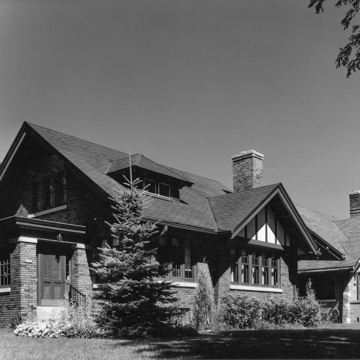Milwaukee’s middle-class residential architecture, especially bungalows, reached a high degree of sophistication during the 1920s. An outstanding group, ranging from simple to ornate, can be found in the N. Grant Boulevard Historic District. This fine residential street also boasts a bevy of houses designed in Arts and Crafts, Colonial Revival, Mediterranean Revival, Tudor Revival, and Prairie Style. But the district’s real significance lies in its illustration of the Craftsman bungalow as it evolved between 1910 and 1930.
Wisconsin’s early Craftsman form is exemplified by the Fred Eitel House (1914) at 2425 N. Grant Boulevard. This wooden one-and-a-half-story residence with its deep front porches typifies the thousands of Craftsman bungalows built throughout Wisconsin from 1905 to 1930. The Eitel house illustrates such Craftsman characteristics as a broad front porch, pseudo-structural ornament, and informal one-floor living. More costly brick and stucco materials were used at 2410, 2452, 2458, 2453, 2457, 2463, 2471, and 2476 N. Grant. They all feature exposed rafter tails, exaggerated knee-brace brackets, plain bargeboards, and grouped windows. Similar houses line other blocks along Grant Blvd.
By the end of World War I, the California bungalow, with its broad, open front porch and low-pitched roof, evolved to suit the Wisconsin climate and satisfy the demand for expandable attics and especially for sunrooms, which became an almost indispensable feature for up-to-date houses. In some, an open terrace stretched across the front of these houses, replacing the covered front porch and bringing more light to the living room. Contractors offered many with permanently glazed porches, such as the Peter Sprecher House (1920; 2728 N. Grant), and many older Craftsman bungalows had their open front porches converted to sunrooms. The newer bungalows replaced the big, open front veranda with a glazed porch tucked into the front corner as at the Reinhold Marquardt House (1920; 2737 N. Grant).









